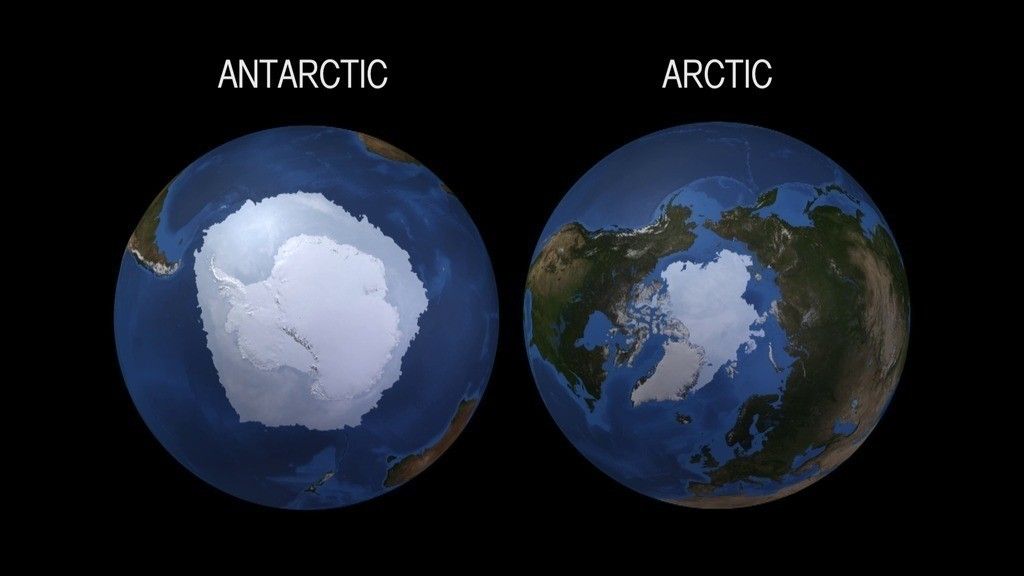We often get questions from readers about Earth’s sea ice in the Arctic and the Antarctic, and the differences between those areas. Arctic sea ice has declined over the past five decades, while Antarctic sea ice has increased, and then declined. Why do they behave differently?
How They’re Different
The primary difference between the Arctic and Antarctica is geographical. The Arctic is an ocean, covered by a thin layer of perennial sea ice and surrounded by land. ("Perennial" refers to the oldest and thickest sea ice.) Antarctica, on the other hand, is a continent, covered by a very thick ice cap and surrounded by a rim of sea ice and the Southern Ocean.
The Arctic Ocean is very deep and closely linked with the climate systems around it, making it more sensitive to climate changes than Antarctica.
During the centuries of human exploration in the Arctic, sea ice covered the Arctic Ocean well year-round, up until recent decades. But satellite observations show that Arctic sea ice has been declining in extent*, thickness and volume since 1979.1 Average Arctic sea ice extent is at its lowest since 1850.
During the summer melt season, the sea ice’s edge retreats toward the North Pole, only to re-grow during the Arctic winter. As a result of ongoing warming driven by human activities, the trend toward summer sea ice loss (from July to September, followed by a winter re-growth) continues.
Recent research suggests that there is a relationship between Arctic sea ice losses and the human burning of fossil fuels in all months.2 Aerosols (tiny particles suspended in the atmosphere) tied to human activities have offset some of the Arctic sea ice extent loss trend; a reduction in aerosol pollution will likely see a sea ice loss acceleration.3 Ice loss at the sea ice’s margins** results in winds driving warmer water beneath the Arctic sea ice, increasing the amount of heat the Arctic Ocean stores 4 and priming conditions for further sea ice loss.
A figure showing current Arctic sea ice extent can be found here.
Antarctic Sea Ice
Antarctic sea ice expands during the winter, only to melt back largely to the continent’s edge in summer.
Antarctic sea ice extent is currently below the long-term average of all decades prior since 1979. Previously, Antarctic sea ice extent had been above that long-term average due to long-term, large-scale wind circulation patterns that drove sea ice away from Antarctica5, making room for more sea ice to form nearer to the continent.6 Climate models, or computer simulations that incorporate all the factors that affect Earth’s climate, predicted this behavior.7 These long-term wind patterns reversed several years ago, resulting in a significant sea ice decline surrounding Antarctica. Values since then have been hovering around the average of all years prior in the satellite record. A figure showing current Antarctic sea ice extent can be found here.

Why Sea Ice Matters
Some of the questions we receive ask why we should care about the polar regions. These regions are very important in regulating global temperature. Because sea ice has a bright surface, 50-70 percent of incoming energy is reflected back into space. As sea ice melts in the summer, it exposes the dark ocean surface. Instead of reflecting 50-70 percent of the sunlight, it absorbs 90 percent of the sunlight. As the ocean warms, global temperatures rise further.
Also, what happens in the polar regions doesn’t stay in those regions. Their changes affect global temperatures and can even change ocean circulation. Earth’s sea ice is very attuned and responsive to even small changes in global surface and ocean temperatures.
Learn More
- What’s the deal with Antarctica and the Arctic?
- NASA's Earth Observatory: Arctic sea ice
References
- New Year Lows Once Again, NSIDC; Kwok, R. (2018), Arctic sea ice thickness, volume, and multiyear ice coverage: Losses and coupled variability (1958 – 2018). Environ. Res. Lett. 13 (2018) 105005 https://doi.org/10.1088/1748-9326/aae3ec; and
Arctic Sea Ice Volume Anomaly, Polar Ice Center - Julienne Stroeve and Dirk Notz, Changing state of Arctic sea ice across all seasons, Environmental Research Letters, Volume 13, Number 10
- B. L. Mueller, Attribution of Arctic Sea Ice Decline from 1953 to 2012 to Influences from Natural, Greenhouse Gas, and Anthropogenic Aerosol Forcing, https://doi.org/10.1175/JCLI-D-17-0552.1
- Mary-Louise Timmermans, John Toole and Richard Krishfield, Warming of the interior Arctic Ocean linked to sea ice losses at the basin margins, Science Advances 29 Aug 2018: Vol. 4, no. 8
- All About Sea Ice, NSIDC
- Gerald A. Meehl et al, Antarctic sea-ice expansion between 2000 and 2014 driven by tropical Pacific decadal climate variability, https://doi.org/10.1038/ngeo2751
- A Tale of Two Poles, Earth Observatory, 2014
*Sea ice extent is a measurement of the area of ocean where there is at least some sea ice.
**Margins are transition regions between the ice-covered and ice-free portions of the ocean.

































